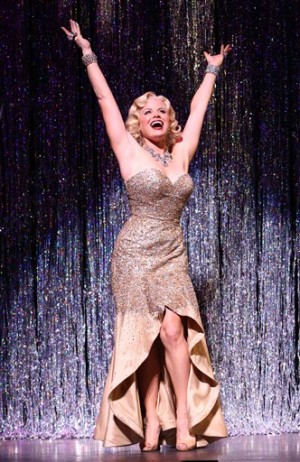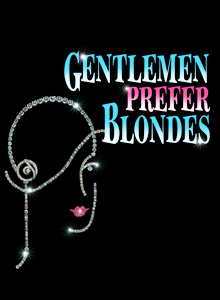“Everyone knows how to fix everyone else’s show.”
Those words were imparted to me after the Wednesday evening performance of 9 to 5 by a journalistic acquaintance. The musical version of the 1980 film of the same name was one of the more anticipated Broadway shows this past season. However, it was met with critical negativity and audience indifference, in spite of a score by Dolly Parton and a leading lady turn by Allison Janney. The show closed yesterday after 148 performances. I decided to take in the show before it closed just because I was curious to see just what went wrong, and also to see Ms. Janney onstage.
The show is a mess, there’s no getting past that. However, in the ruins of the musical there lies the promise of what could have been a better production. The fault lies mostly with director Joe Mantello, choreographer Andy Blankenbuehler and librettist (and co-writer of the original screenplay) Patricia Resnick. The original film is an amusing satiric fantasia of three women (Lily Tomlin, Jane Fonda and Dolly Parton) enacting revenge on their repugnantly chauvinistic boss (a delightfully crass Dabney Coleman). The film holds up as an amusing period piece, even if its Oscar-nominated title song is probably better remembered than the movie itself. The musical tries very hard to be the film, but without making the necessary changes needed for it to be a fully functional musical – namely, a well-structured, clever book and a score that serves the story – it falls considerably short.
As the lights go down, that famous vamp starts up, setting off a series of cheers from the audience. Suddenly I was very innervated as the show curtain (cleverly made up entirely of telephone cords – remember those?) rose for the opening/title song. My disappointment was almost immediate as the first line of the song was sung by… a man? It was clear from the get-go that the show was lacking some sense of focus. “9 to 5” may be a recycled show tune, but it was still the best song in the score (a la “Never on Sunday” in Illya, Darling). The rest of my night was figuring out ways to fix the show to make moments like that actually work. (My idea for the opening? Cut the chorus from the first minute and a half of the song, give the lines to the three ladies as they prepare their mornings and bring the ensemble into the street scene).
In fact, the chorus pretty much sings and dances innocuously throughout. Assisting where they are not needed, including offstage singing back-up during “Backwoods Barbie” or filling out “I’m Gonna Shine Like the Sun” to close the first act. It didn’t help that they were given generic “look ma, I’m dancin'” choreography by Tony award winner Andy Blankenbuehler. In fact, most of the dancing was uninspired and at times, rather pathetic. Office scenes aside, the chorus padded out the rest of the musical numbers for the sheer idea of giving them more to do. You could easily streamline the show and cut the chorus without much loss to any of the musical numbers – at most
Onto the most prolific person behind 9 to 5 the Musical, Dolly Parton. What more is there to say about this diminutive titan of the music industry? Composing hundreds of songs for herself and other artists, selling countless records and one of the most recognizable figures in the world, Dolly decided to take on the arduous task of writing a musical theatre score. If the score fails to meet the expectations of a Broadway musical, I am wary of putting the entire blame on Ms Parton. If her lyrics tended to be generic and more than frequently cliched, the melodies were mostly hummable and there was at least some considerable effort on her part as both composer and especially as the show’s champion. With the exception of librettist Resnick, Ms. Parton was surrounded by Tony-winning musical theatre professionals who should have known better.
What made the musical entertaining were its three leading ladies. When they were onstage there was some sparkle and excitement in spite of the quality of the show around them. Megan Hilty was all beauty and heart as Doralee Rhodes, taking on the role originated by Parton in the film. While the performance is more impersonation of Parton than an original characterization, the young actress made the most of it especially with “Backwoods Barbie,” one of the better numbers.
There is surprisingly very little to the character of Judy who goes from dejected insecure housewife to defiant independent working woman. Part of the problem is that there isn’t much of an arc for the most dynamic of the three leading ladies – it’s obvious she changes but we never really see how. However, the part was well sung by Stephanie Block, who was given the eleven o’clock number, “Get Out and Stay Out.”Judy tosses her husband out halfway through the song, and delivers a powerhouse finish, but I wish the director had thought to keep the character onstage so she would have someone to play to. It’s like taking a production of Follies and having Ben walk out on the line “Wait, I’m just beginning” as Phyllis continues ‘Could I Leave You?’ by herself.
Then we get to the star of the production. Ms. Allison Janney is well known for her four time Emmy winning role of C.J. Cregg on The West Wing, but she also has innumerable film and stage credits to her name. In the months leading up to my visit to the show, I’d read that Ms. Janney can’t sing and can’t really dance but that it didn’t matter. Vocal and dance limitations aside, Ms. Janney can hold a tune and moves well and walks away with the show whenever she is onstage. This is probably the best musical debut debut of a non-musical performer since Lauren Bacall opened in Applause. (By the way, Encores, Janney is your Tess Harding. Now dust off Woman of the Year). In the eleventh hour, Janney stopped the show with a feminist tirade that would have made Dixie Carter proud. On top of that, she also looked like she was having the time of her life singing and dancing and giving one hell of a star turn.
As for the men, well there haven’t been such thankless roles for men in a musical since the divas of Mame mopped the floor with them in 1966. Marc Kudisch has the most to do as Franklin Hart, Jr., the boss from hell, a role he performed with gusto. However it seemed redundant to give him not one but two songs expressing his vulgar misogny. Andy Karl is the younger accountant with a romantic interest in Violet. Karl, who was part of Legally Blonde, has little to do aside wear period glasses and duet with Janney on a real dud, “Let Love Grow.”
Then there was Kathy Fitzgerald, bless her heart. I first became aware of her in The Producers where she played several bit parts, most notable Shirley Markowitz, the lesbian lighting designer with the basso profundo voice in “Keep it Gay.” In 9 to 5, Fitzgerald played Roz, the busybody executive secretary whose unrequited love for the boss has her doing his bidding without question or pause. Ms. Fitzgerald got some of the biggest laughs of the evening, though her first number was too long.
One of the main problems is that there was too much of what was bad and too little of what was good. The main thing about adapting a property to the musical stage is that you want to be able to say something that hasn’t been explored in any previous incarnation, whether it’s a novel, play or film. One of the major problems with 9 to 5 was a slavish adherence to the film’s screenplay, and certain things just didn’t adapt well. When The Producers and Hairspray were adapted for Broadway, their great success was in finding a new way to tell the story (and it didn’t hurt that both had Thomas Meehan on hand to assist). First-timer Resnick could have used a pro like him to help her with the structure and pinpointing the reason why these characters were bursting out into song. Oh – and not to mention two groan inducing moments: quoting “No good deed goes unpunished” and “I will always love you.”
From the opening number onward, and well past midnight after getting home, I couldn’t help but play show doctor. I made mental notes and ran the show over and over in my head thinking of ways to fix it and make improvements. The mental results I came up with would make for a sturdier show, but the more I think about it, did 9 to 5 really need to be a musical? However, I hope Dolly doesn’t desert Broadway altogether – I think the combination of the two was a nice touch (then again, how can you not like Dolly?!) but I hope if she ever comes to town with a show I only hope she’s got a creative team that won’t let her down.


